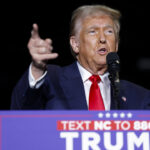White House national security adviser Jake Sullivan defended U.S. tariffs on Chinese imports, stating that they helped prevent another “China shock.”
The Biden administration announced in May that it would continue existing Trump-era tariffs on Chinese goods while imposing new duties on $18 billion of imports in strategic sectors, including electric vehicles.
Speaking at the Brookings Institution in Washington, Sullivan explained the reasoning behind this decision.
“The PRC is producing far more than domestic demand, dumping excess onto global markets at artificially low prices, driving manufacturers around the world out of business and creating a choke hold on supply chains,” Sullivan said.
“To prevent a second China shock, we’ve had to act. That’s what drove the decisions about our 301 tariffs earlier this year,” he said, referring to President Joe Biden’s decision to impose new tariffs under Section 301 of the Trade Act of 1974.
Sullivan noted that the issue of excess supply is a broader trend seen across multiple sectors vital to U.S. economic security, including critical minerals, solar cells, lithium-ion batteries, and electric vehicles.
“Previous efforts to build a China policy on changing China have not succeeded,” Sullivan added.
Therefore, he said, the United States needs to adopt a new set of strategies based on the current geopolitical and economic realities.
He highlighted, for example, the challenges facing the critical minerals sector and how Washington is working with its partners to address them. He said the sector is characterized by extreme price fluctuations, widespread corruption, inadequate labor and environmental protections, and high concentration in China.
He added that Beijing is artificially reducing prices to keep foreign competitors out of the marketplace.
“If we and our partners fail to invest, the PRC’s domination of these and other supply chains will only grow, and that will leave us increasingly dependent on a country that has demonstrated its willingness to weaponize such dependencies,” he said.
He said the United States and its partners are working on a solution to create “a high-standard critical mineral marketplace.”
“And we’re driving toward tangible progress on that idea in just the next few weeks,” he said.
Former President Donald Trump imposed tariffs on more than $300 billion worth of Chinese goods to respond to an array of unfair trade practices, including intellectual property theft.
The Biden administration has opted to keep all of them in place and announced more tariffs on goods, including EVs, solar panels, medical equipment, lithium-ion batteries, steel, and aluminum.
Both administrations have used tariffs to level the playing field for domestic manufacturers and protect American workers. An August poll by the CATO Institute, a Washington-based think tank, found that a majority of Republicans and Democrats support tariffs levied by their party but not the opposing party.
While Biden’s tariff policies mirror those of Trump, there’s a notable difference in Biden’s strategy, Sullivan argued.
The Biden administration has used tariffs in a “smart and strategic way,” he said, noting that they are aimed at high-impact industries, such as EVs and semiconductors.
Trump has repeatedly said on the campaign trail that he would raise China tariffs to 60 percent and apply at least 10 percent tariffs to goods imported from other countries.
Meanwhile, Vice President Kamala Harris’s position on tariffs is less clear. She opposed Trump’s plan to raise tariffs on China and has refrained from commenting on the current administration’s continuation of tariffs on Chinese goods. However, she pledged to prevent unfair trade practices that allow the Chinese regime to undermine American jobs and manufacturing.
Beginning on Sept. 27, the tariff on Chinese EVs quadrupled from 25 percent to 100 percent.
In addition, the Office of the U.S. Trade Representative (USTR) announced a 100 percent tariff on needles and syringes, 50 percents tariff on semiconductors, solar cells, face masks, and surgical gloves, and 25 percent tariffs on EV and other batteries, battery parts, critical minerals, steel and aluminum products, and ship-to-shore cranes.
Some of the increases took effect on Sept. 27, while others will take effect on Jan. 1 of each of the next two years.
Terri Wu and Lily Zhou contributed to this report.
Please rewrite this sentence.
Source link





